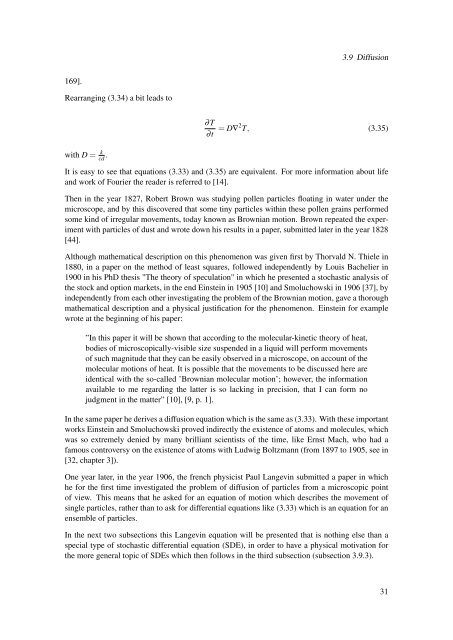Diffusion Processes with Hidden States from ... - FU Berlin, FB MI
Diffusion Processes with Hidden States from ... - FU Berlin, FB MI
Diffusion Processes with Hidden States from ... - FU Berlin, FB MI
Create successful ePaper yourself
Turn your PDF publications into a flip-book with our unique Google optimized e-Paper software.
3.9 <strong>Diffusion</strong>169].Rearranging (3.34) a bit leads to∂T∂t= D∇ 2 T, (3.35)<strong>with</strong> D = kcd .It is easy to see that equations (3.33) and (3.35) are equivalent. For more information about lifeand work of Fourier the reader is referred to [14].Then in the year 1827, Robert Brown was studying pollen particles floating in water under themicroscope, and by this discovered that some tiny particles <strong>with</strong>in these pollen grains performedsome kind of irregular movements, today known as Brownian motion. Brown repeated the experiment<strong>with</strong> particles of dust and wrote down his results in a paper, submitted later in the year 1828[44].Although mathematical description on this phenomenon was given first by Thorvald N. Thiele in1880, in a paper on the method of least squares, followed independently by Louis Bachelier in1900 in his PhD thesis "The theory of speculation" in which he presented a stochastic analysis ofthe stock and option markets, in the end Einstein in 1905 [10] and Smoluchowski in 1906 [37], byindependently <strong>from</strong> each other investigating the problem of the Brownian motion, gave a thoroughmathematical description and a physical justification for the phenomenon. Einstein for examplewrote at the beginning of his paper:”In this paper it will be shown that according to the molecular-kinetic theory of heat,bodies of microscopically-visible size suspended in a liquid will perform movementsof such magnitude that they can be easily observed in a microscope, on account of themolecular motions of heat. It is possible that the movements to be discussed here areidentical <strong>with</strong> the so-called ’Brownian molecular motion’; however, the informationavailable to me regarding the latter is so lacking in precision, that I can form nojudgment in the matter” [10], [9, p. 1].In the same paper he derives a diffusion equation which is the same as (3.33). With these importantworks Einstein and Smoluchowski proved indirectly the existence of atoms and molecules, whichwas so extremely denied by many brilliant scientists of the time, like Ernst Mach, who had afamous controversy on the existence of atoms <strong>with</strong> Ludwig Boltzmann (<strong>from</strong> 1897 to 1905, see in[32, chapter 3]).One year later, in the year 1906, the french physicist Paul Langevin submitted a paper in whichhe for the first time investigated the problem of diffusion of particles <strong>from</strong> a microscopic pointof view. This means that he asked for an equation of motion which describes the movement ofsingle particles, rather than to ask for differential equations like (3.33) which is an equation for anensemble of particles.In the next two subsections this Langevin equation will be presented that is nothing else than aspecial type of stochastic differential equation (SDE), in order to have a physical motivation forthe more general topic of SDEs which then follows in the third subsection (subsection 3.9.3).31









